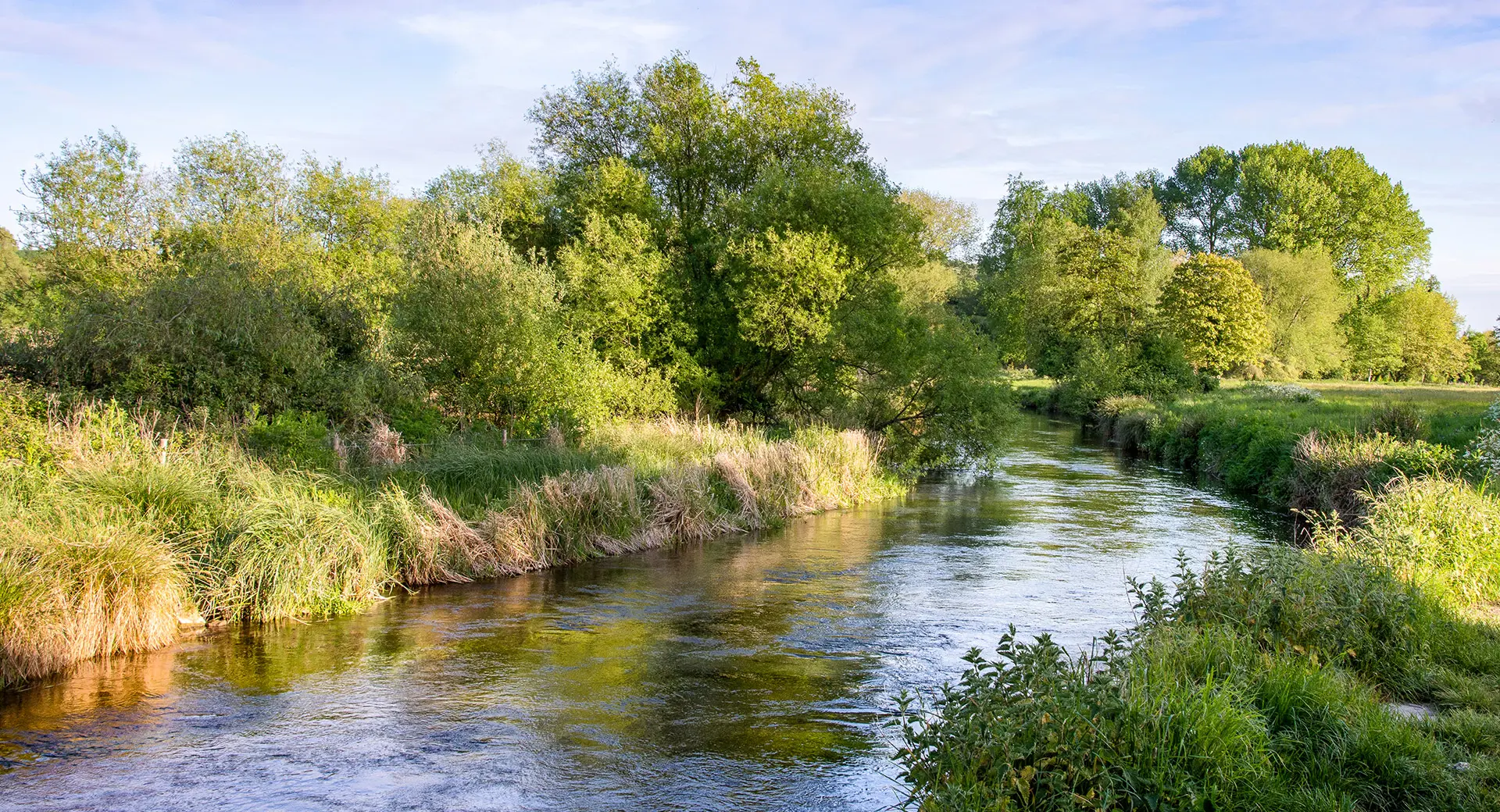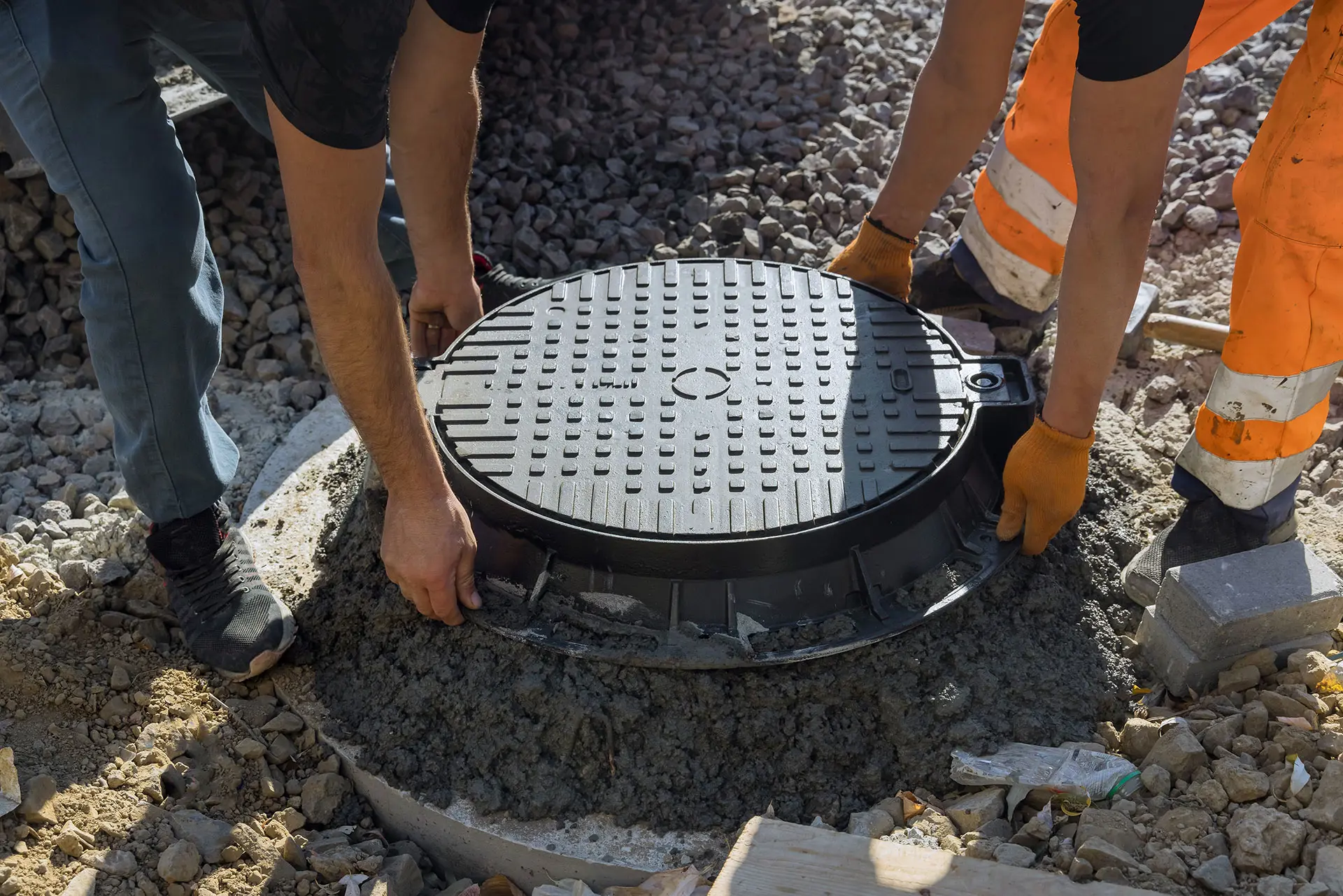1. Overview for the Arun and Western Streams Catchment
You can find all the documents relating to the below in the downloads at the bottom of this page.
Our DWMP sets out our priorities for the Arun and Western Streams River Basin Catchment.
- Reducing the number of spills from the 90 storm overflows which together currently spill around 2,600 times per annum.
- Separating or attenuating excess rainwater in the sewer networks to reduce the risks of flooding and frequency of storm overflow discharges, especially in Fittleworth, Loxwood, Chiddingfold, Northchapel and Billingshurst.
- Investigating the potential impact of wastewater discharges on Good Ecological Status at the Aldingbourne Rife and the River Arun.
- Planning for potential significant developments at Bersted, Horsham, the old Ford Airfield, Arundel, Southleigh, Southbourne, Tangmere, Bracklesham, Barnham and Littlehampton.
- Considering the Manhood Peninsular (Sidlesham and Pagham systems) for a catchment approach to tackle multiple water-related issues. This includes climate change, sea level rise, flooding, water resources, water quality, new development, biodiversity and habitat loss.
- Improving the resilience of our networks and treatment works to prevent pollution incidents, particularly in Bosham, Horsham, Barnham (Lidsey) and Siddlesham.
- Reducing the risk of sewer blockages by increasing sewer jetting and targeting customer campaigns to reduce the amount of FOG (fats, oils and grease) and non-flushables in the sewer network around Horsham, Littlehampton, Bognor Regis, Nutbourne and Emsworth.
Arun and Western Streams River Basin Catchment
Across the Arun and Western Streams we have:
Arun and Western Streams River Basin Catchment
Across the Arun and Western Streams we have:
59
Sewerage catchments
4,011
Kilometres of sewers
56
Wastewater Treatment Works
434
Wastewater Pumping Stations
12%
The percentage of the region that's connected to a mains sewer.
93%
The percentage of homes connected to a mains sewer.
83%
The percentage of businesses connected to a mains sewer.
2. Working with others
We've worked with a wide range of organisations with responsibilities for drainage, flooding and protection of the environment while developing our DWMP. The organisations we worked with in the Arun and Western Streams River Basin Catchment include:
- West Sussex County Council
- Surrey County Council
- Chichester District Council
- Adur and Worthing Councils
- Mid Sussex District Council
- Arun District Council
- Horsham District Council
- Waverley Borough Council
- The Environment Agency
- The South Downs National Park Authority
- The Arun and Rother Catchment Partnership and member organisations including:
- The Arun and Rother Rivers Trust
- The Sussex Wildlife Trust
- The Royal Society for the Protection of Birds
- Thames Water
- Portsmouth Water
Working together to co-create the DWMP is important. Our drainage and wastewater systems are often interconnected with the systems managed and operated by others and affect the natural environments within the catchment.
Issues and concerns
A wide range of issues and concerns have been raised and discussed throughout the development of the DWMP for the Arun and Western Streams.
- Some of the wastewater systems in the RBC are approaching their permit and capacity limits as a result of new development. So, the permits will need to be reviewed with the Environment Agency.
- There are numerous environmentally designated sites in the Arun Valley, including internationally designated sites. The water quality needs to be protected and improved so the species and habitats these sites support can be protected from further deterioration and enhanced.
- Data sharing between multiple organisations is needed to promote closer working and co-create more sustainable, natural solutions to land drainage.
- Private sewers are likely to be causing issues with infiltration and leakage.
- Effluent reuse must be considered as a solution to reduce discharges to Langstone and Chichester Harbours.
- West Sussex Council and other organisations are actively looking for potential natural flood management sites and ways to slow the flow of rainfall runoff, including the use of Horsham Pond as a storage facility.
We're progressing these issues through the development of the DWMP as set out in our investment needs for the Arun and Western Streams. Furthermore, we commit to working with others to co-develop and co-deliver schemes that meet multi-organisational objectives and which benefit the environment, our customers and communities.
3. Workshop presentations
We developed and ran a series of activities between 2020 and 2022 as we prepared our DWMP for the Arun and Western Streams. This included regionally-based workshops that presented and discussed issues and information relevant across the whole of our operating region.
Workshop 1
Held in September 2020, participants discussed the findings of the risk based catchment screening (RBCS) and proposed additional planning objectives for the DWMP.
Workshop 2
Held in May 2021, participants:
- discussed the results from the BRAVA risk assessments and the proposed investment strategy for the wastewater catchments within the river basin
- identified the generic options that should be explored to address the identified risks, and
- discussed which wastewater catchments to progress through the Options Development and Appraisal stage of the DWMP.
Workshop 3
Held in March 2022, we reviewed and discussed the draft investment programme for the Arun and Western Streams. This included the types of investment, priorities and timing for investment needs. It also covered the wider opportunities arising from the proposed investment in terms of partnership projects and catchment-wide solutions providing multiple benefits.
Workshop presentations can be download at the bottom of this page and you can view the findings from our interim consultation.
4. Risk based catchment screening for the Arun and Western Streams Catchment
Risk based catchment screening (RBCS) is a process that uses existing, readily available data. This data helps us identify where there's a current and/or potential risk or vulnerability in the sewer catchment to future changes, such as new residential development or changes in climate. This enables effort to be focused on these catchments during the development of the DWMP in order to understand these risks in more detail and why they're likely to occur.
The RBCS involves the assessment of each sewer catchment against 17 indicators set out in guidance published by Water UK. Water companies can add additional indicators to ensure that other important issues are highlighted at this early stage in the development of the DWMPs. We've included an additional metric on customer complaints as this provides a flag for catchments with ongoing or outstanding concerns.
Find out more about the risk based catchment screening process.
5. BRAVA for the Arun and Western Streams Catchment
The Baseline Risk and Vulnerability Assessment (BRAVA) is an important step in the development of our DWMP. It helps us understand current system performance and future vulnerabilities. This means that we can identify the investment needed to manage and reduce the risks to band 0 (no significant level of risk).
A BRAVA assessment has been completed for each of the wastewater systems in the Arun and Western Streams that were flagged during the risk based catchment screening (RBCS). A risk assessment was completed for all 14 planning objectives.
The output of the BRAVA shows:
- the current risks and issues in each wastewater system within the Arun and Western Streams catchment – providing a baseline from which we can assess future risks
- the future risks in 2030, 2035, 2045 and 2050 (where the methodology currently allows us to assess the future risks) so we can understand how the current risks may change without additional investment
- the key issues behind the future changes in risk including:
- a deterioration in the condition in our wastewater systems
- climate change – including the increasing frequency and severity of droughts and storms
- growth and urban creep
- a combination of any or all of these that are relevant in the catchment being assessed.
You can view or download the results for the BRAVA for the Arun and Western Streams River Basin Catchment below.
Notes
- In the BRAVA results table, “not flagged” means no risks were identified in the initial RBCS using the nationally set criteria. Wastewater systems not flagged were screened out and did not progress to the BRAVA stage. “Not applicable” means the planning objective was not relevant within the wastewater system. For example, where a system has no storm overflows, this will be marked as “Not applicable”.
- Please check the DWMP glossary for any unexplained acronyms.
6. Problem Characterisation
The Problem Characterisation stage of the DWMP uses the results from the Baseline Risk and Vulnerability Assessment (BRAVA) to explore the causes of risks and the primary drivers. A technical summary provides information on our approach to the Problem Characterisation stage.
Current risks in the Arun and Western Streams Catchment
Problem Characterisation shows how many wastewater systems have a risk under each of the 14 planning objectives. For example, for the risk of internal flooding, 48 wastewater systems are in band 0 (not significant), three are in band 1 (moderately significant), two are in band 2 (very significant) and seven were ‘not flagged’ for inclusion (i.e. screened out at the RBCS stage of the DWMP).
Storm overflows and nutrients are the main concerns in this river basin based on the BRAVA results for 2020.
The wastewater systems with the highest number of planning objectives in band 2 (very significant) are Chichester, Siddlesham, Chiddingfold, Lidsey, Ford, West Marden, Warnham and Billingshurst, all with four objectives in band 2 for 2020. Loxwood and Thornham both have two band 2 risks. All other catchments have two or fewer risks.
The specific risks and the causes of risk for each of the wastewater systems are explained in the summary of the Problem Characterisation for each system.
(a) Population Growth
There are several wastewater catchments where new homes, businesses, roads and other infrastructure are planned to provide for the increasing population. The main areas identified for potential new development in the Arun and Western Streams Catchment are:
- Ford
- Lidsey
- Horsham
- Chichester
The BRAVA results show that the additional homes and businesses will increase the risks of non-compliance with our Dry Weather Flow (DWF) permits from the Environment Agency in 19 of the 60 wastewater systems. This includes Ford, Chichester, Sidlesham, Lidsey, Petersfield, South Ambersham, Pulborough and Billingshurst. This means further investment will be needed in the future to increase the capacity of our treatment works to accommodate the new homes and businesses.
The additional development may mean that our current permits for wastewater treatment quality might be exceeded by 2050 (without further investment) in three wastewater systems, Warnham, Faygate and Liss Hillbrow.
New development in the Arun and Western Streams Catchment might put additional pressure on internationally designated habitat sites such as Arun Valley and Solent areas. So, solutions will need to be found to ensure that development is nutrient neutral.
A map of the catchment showing the estimated future growth in each wastewater system is shown below. The technical summary explains how we have considered population growth and urban creep in our DWMP.

(b) Climate change
Climate change will bring greater variability of our weather with warmer wetter winters and hotter drier summers. As a result of this, we may see more intense summer storms that exceed the capacity of the drainage and wastewater networks and cause localised flooding. Hence, the risk of flooding from sewer systems is increasing due to climate change. The technical summary explains how we have considered climate change in our DWMP.
We'll work with partner organisations, such as West Sussex County Council and the Environment Agency, who have responsibilities for flooding and drainage to consider options and develop opportunities to find solutions that reduce the risks from flooding.
We'll need to adapt our wastewater systems to operate in future climates. There will be an increasing need to slow the flow entering our sewer networks so the systems can carry the water without flooding homes and businesses and/or without causing discharges from storm overflows. Preventing additional rainfall entering foul sewer networks, including combined sewer networks where possible, could delay the need to upgrade and enlarge the vast underground network of sewers.
Climate change is expected to have an impact on the risk of flooding in several wastewater systems, especially Ford, Horsham New, Sidlesham, Petersfield, Billingshurst, Chephurst Copse Rudgwick and Fernhurst where there is already a very significant risk from rainfall-related flooding. The flooding risks will increase in other wastewater systems by 2050 unless measures are taken to manage and reduce these risks. The risk assessment indicates that storm overflow discharges might increase for the Bosham wastewater system unless further action is taken, although 16 systems already have a very significant risk of discharges from storm overflows.
The map below shows the potential impact of climate change, urban creep and growth on the risk of flooding in a 1-in-20-year storm for the wastewater systems. We followed Water UK’s capacity assessment framework to apply a 20% uplift to rainfall forecasts to assess the potential increases in flood volumes shown on the map. Urban creep was estimated using the approach developed by the UK Water Industry Research (UKWIR) report on Urban Creep in sewerage systems (2010).

The map highlights that we'll need to adapt to climate change. Adaptation will mean considering better long-term sustainable options, such as reducing the volume of rainwater entering the sewer network. This approach may provide the capacity within the wastewater system to allow for future growth, therefore reducing both the need for significant increases in the capacity of the existing wastewater systems and reducing discharges from storm overflows.
Investment planning for each wastewater system
We used the BRAVA results and our understanding of the causes of risks and drivers to propose an investment strategy for each of the wastewater systems. These strategies help us to target the wastewater systems that need further investment to reduce the potential risks to customers and the environment.
We used a risk-based approach to identify the wastewater systems that we need to progress in this first round of DWMPs. For these systems, we'll develop an investment plan. Our technical summary sets out how we selected the systems to take forward.
The maps and causes of risks for the remaining wastewater systems in the Arun and Western Streams will be published when available.
7. Options Development and Appraisal
Our approach to Options Development and Appraisal (ODA) is explained in the technical summary.
Generic options
We commenced the ODA process at the river basin catchment (RBC) scale (level 2 planning). This enabled us to look across all the wastewater systems in the river basin and consider generic options that could work at the catchment scale, as well as those specific to a wastewater system.
The generic options are grouped into those that help tackle the risks at ‘source’, those that help to improve the wastewater system, ‘the pathway’, and those that protect or mitigate the impacts on the receiving waterbodies, ‘the receptors’. This process helped to identify the types of options that could be used individually or in combination with other options to address the risks.
We held meetings with partner organisations to build upon the list of generic options relevant to each wastewater system. As a group, we identified and proposed ‘unconstrained’ options to tackle the drivers and causes of risks identified during the Problem Characterisation stage of the DWMP. We then progressed these unconstrained options through the Options Development and Appraisal stage.
Options development and appraisal
The options appraisal involved evaluating each of the options in two stages. Firstly, to screen out unviable options to leave a set of ‘constrained’ options, and then a second stage to reduce the list further to leave only potentially ‘feasible’ options (see the Options Development and Appraisal technical summary for full details of this process). The process for evaluating the benefits and how we've taken the environment into account is set out in ourStrategic Environmental Assessment (SEA) Scoping Report and the SEA Progress Report.
Only feasible options with positive benefits proceeded to the costing stage. This resulted in the selection of the preferred options and confirmed whether each was ‘least cost’ or provided ‘best value’.
The documents in the links below show the feasible options and how we applied the process within each wastewater system. Beginning with the generic options through the appraisal stages, the tables show the point at which some options were rejected and why. If an option wasn't rejected, it was costed and became either the final best value or the least cost preferred option (see ODA technical summary for details of this process).
Our final preferred options are set out in the investment needs tables for each wastewater system. The accompanying maps show the location of the proposed options within the wastewater system.
Please check the DWMP glossary for any unexplained acronyms.
The options and investment needs are not committed funding but an identification of the needs for funding. We'll include these options in our future business plans as part of the Ofwat periodic review of water company funding to secure the investment needed to implement them.
8. Programme Appraisal
The next stage follows on from the Options Development and Appraisal (ODA) stage, which identified the preferred options for investment in our wastewater systems.
The Programme Appraisal brings the investment needs for each wastewater system together into an investment needs programme for the Arun and Western Streams. We look across the river basin catchment to review the investments needed, the timing of these needs and how they combine to reduce the risks to our customers and the environment.
We also look at the wider risk reduction that each option provides across all the planning objectives. Some actions, like separating rainwater from wastewater sewers, could reduce risks under several planning objectives such as storm overflows, external flooding, bathing water quality, shellfish water quality and good ecological status. The details of the method for prioritisation can be found in our Technical Summary of the Programme Appraisal.
The investment needs in the Arun and Western Streams River Basin Catchment include:
- reducing the number of spills from the 90 storm overflows which together currently spill around 2,600 times per annum
- separating or attenuating excess rainwater in the sewer networks to reduce the risks of flooding and frequency of storm overflow discharges, especially in Fittleworth, Loxwood, Chiddingfold, Northchapel and Billingshurst
- investigating the potential impact of wastewater discharges on Good Ecological Status at the Aldingbourne Rife and the River Arun
- planning for potential significant developments at Bersted, Horsham, the old Ford Airfield, Arundel, Southleigh, Southbourne, Tangmere, Bracklesham, Barnham and Littlehampton
- considering the Manhood Peninsular (Sidlesham and Pagham systems) for a catchment approach to tackle multiple water-related issues. This includes climate change, sea level rise, flooding, water resources, water quality, new development, biodiversity and habitat loss
- improving the resilience of our networks and treatment works to prevent pollution incidents, particularly in Bosham, Horsham, Barnham (Lidsey) and Siddlesham
- reducing the risk of sewer blockages by increasing sewer jetting and targeting customer campaigns to reduce the amount of FOG (fats, oils and grease) and non-flushables in the sewer network around Horsham, Littlehampton, Bognor Regis, Nutbourne and Emsworth.
Investment Needs for the river basin catchment
We progressed 10 wastewater systems through the ODA stage in the first cycle of the DWMP. These 10 wastewater systems serve a population of around 323,000 which is approximately 78% of customers in this river basin catchment.
We extrapolated the investment needs for these 10 systems to the other 49 systems in the Arun and Western Streams River Basin Catchment. This provides an estimate of the total investment needs required to reduce the risks in all our wastewater systems in the catchment to Band 0 (not significant). This concept of “Band Reduction” and full details of the process for extrapolation is explained in the Technical Summary on Programme Appraisal.
The programme appraisal for the Arun and Western Streams has identified the following:
- a total of 92 band reductions are required in 2020 to reduce the risks across the 14 planning objectives in the 10 wastewater systems
- by 2050, this requirement will increase to 107 band reductions due to the impact of climate change, growth and creep
- the options identified to date would cost around £517 million for the 10 systems and are expected to provide 44 Band reductions in 2050 (the options do not result in a band 0 for all risks).
- the Arun and Western Streams River Basin consists of 59 wastewater systems, which require 234 band reductions in 2020 and 276 band reductions by 2050 in order to achieve band 0 across 14 planning objectives.
- extrapolating the investment needs for all the systems in the Arun and Western Streams will cost around £1.46 billion for a population of 412,000. This illustrates the scale of investment needed to get to Band 0 by 2050 for all 14 planning objectives.
These investment needs provide indicative costs that allow us to understand the level of funding required to reduce the risks. The funding hasn't been secured at this stage. The DWMP informs the development of our 5 yearly Business Plan which is submitted to our economic regulator, Ofwat, to agree on how we should invest the money received from our customer bills.
Consultation on the Arun and Western Streams River Basin Catchment
We held a preliminary consultation on our draft DWMP in September and October 2021. The purpose of the consultation was to gain feedback and advice from our customers and organisations on our developing Plan.
We specifically asked about:
- our Strategic Environmental Assessment Scoping Report
- our selection of wastewater systems to take forward into the Options Development and Appraisal stage of the DWMP in the first cycle, and
- our developing plans for each of the 11 river basin catchments.
Our report on the initial DWMP consultation is now available.
When we consulted on the developing plans for the Arun and Western Streams River Basin Catchment, you highlighted key issues for us to take into consideration.
- Chichester, Thornham, Sidlesham, Lavant and Bosham should be prioritised for investment to prevent storm overflow spills and improve effluent quality as they discharge into the highly sensitive Chichester and Pagham Harbours.
- Clean bathing waters are a key economic consideration in the Arun Catchment so routine discharges from storm overflows must be addressed.
- The capacity of our wastewater systems to manage current and future growth should be clarified, particularly at Thornham, Pagham and Loxwood where the number of new homes permitted or proposed already exceeds the estimates of remaining headroom. Consideration should be given to a ‘change’ investment strategy rather than ‘improve’.
- Redundant plant/equipment and infrastructure for pumping, treatment or storm storage could be recommissioned as short-to-intermediate-term remedies to capacity issues.
- High groundwater levels and infiltration impacts headroom in the networks. Nature-based water storage which delivers both biodiversity net gains and carbon sequestration must be considered as solutions to surface water flooding and inundation of the sewer networks.
- The resilience of the wastewater systems to climate impacts, sea level rise and tide locking needs to be improved and operations should be decarbonised and substituted with renewables.
- Proactive action is needed on blockages.
How we responded to the issues raised during the workshops and the preliminary public consultation is set out in our Register of Stakeholder Comments.
We held a full 12-week public consultation on the draft Regional (Level 1) DWMP between Monday 13 June and Monday 05 September 2022. Our Statement of Response and a report and analysis on the consultation is published on the Have your say page.




